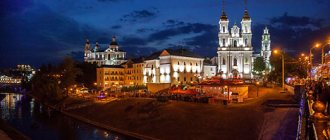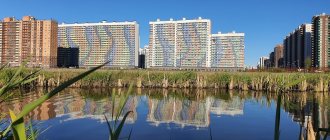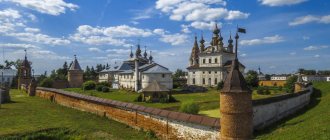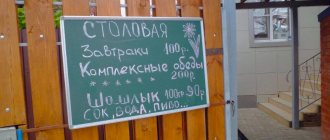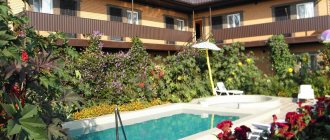In addition to the beautiful picturesque natural monuments for which the South of Russia is so famous, man-made ones, covered in legends and revealing the glorious past of these places in their beauty, attract no less attention. The Krasnodar region presents one of these ancient objects - the village of Ataman - to tourists with special pride; it is considered one of the symbols of the region, reflecting the simplicity and at the same time significance for future generations, their roots.
However, this is not a historical object, but more of a cultural one, which is a kind of exhibition center. It is interesting and fascinating no less than the ethnic information contained in it. It is called a model, but what is important is the opportunity to get acquainted with the unique culture, way of life and way of life of the Kuban Cossacks, real people who lived in this territory centuries ago, and not literary characters.
History of the creation of the ethnographic complex
The idea of recreating the Cossack village in the form in which only local old-timers remember them arose a long time ago and belonged to a group of ethnographers who wanted to reflect the cultural origins of the region in such an unusual way.
3D panorama - at the entrance to the village of Ataman
The leadership of the Krasnodar region also became keenly interested in this idea and fully supported it. But since the events took place in the midst of the notorious economic crisis that broke out in 2008, there was no money for the project.
Then numerous historians, cultural figures and the general public from all over the region joined in the creation of the ethnographic monument and began work with enthusiasm.
Taman was not chosen by chance as the site for the construction of the Ataman complex - here, on the shore of the bay, at the end of the 18th century. The Black Sea Cossacks settled, having fled from the oppression of the Ottoman Empire.
In 1792, the first batch of settlers from the lower reaches of the Dniester and Prut, Colonel Sidor Bely, arrived of the Taman Bay On Bald Mountain they built the first Christian church in these parts and the first Cossack village in the Kuban grew, and the glorious Kuban army was born here.
No traces of the settlement have been preserved, and it cannot be said that the current village, built 200 years later, is a copy of it, but it contains a deep meaning - a return to the beginning, to one’s roots.
The construction of the Ataman Museum took three months of painstaking work - from May to August 2009, the history and culture of the region was recreated bit by bit in material form by the hands of enthusiasts. All buildings were made in full size and with maximum authenticity - both outside and inside, based on old photos and sketches.
Everything was created using technologies and materials used in the 19th and early 20th centuries, such as wood, clay, manure, reeds, thereby repeating the techniques and methods of their ancestors. Additionally, household equipment and household utensils of those times were collected from all regions of the region, which have been preserved to this day in village families.
Don't miss on Taman - Cape Iron Horn , Turkish Fountain and Lermontov Museum
UNLOSSABILITY AND SECRETS
The director of the ethno-tourism complex, Natalia Gezik, sits at a large table covered with a variety of souvenirs. Her phone rings incessantly. Gezik took her position a little over a year ago. During the entire existence of the complex, six managers have changed in it.
She dismisses most questions, for example about financing, with the wording “This is an incorrect question.” She does not answer questions about how much Atamani allocates from the regional budget for its work. How much does the complex earn per working season? Gezik says that he cannot say this because he does not consider it necessary to do so.
According to data posted on the website bus.gov.ru, in 2021 Ataman received government subsidies worth 17 million rubles. The institution’s income in the same year amounted to almost 45 million rubles. The total budget for 2016 is 61.7 million rubles. Expenses for the same period—70 million rubles. In general, despite the ambitions of the ex-governor, after eight years the project has not become profitable and has not yet even reached self-sufficiency.
Horseback riding – © Russiangate / Mikhail Shubin
“We are given government tasks and a certain amount of money is allocated for these state tasks. Budget money, of course, is not enough. But the complex earns enough money to support itself at this stage at which it exists. Of course, we would really like to develop, we don’t earn any money for development,” says the director.
Yes, I would like to build “residential” huts, and even make a hotel - so that people could stay in the village for a couple of days. Yes, most likely we will write a project for investment, says the director. To build a complex with the help of a “public-private partnership.” But about the payback.
What is Ataman today?
Now this is a typical village of Southern Russia - the same as most village-hamlets were in tsarist times. Moreover, each farmstead does not represent a homogeneous type - here are buildings characteristic of each district of the Krasnodar Territory, whose residents were erected.
Another interesting feature of the complex is that each of the exposition buildings was erected according to an individual model, only by residents of one specific area. It is represented by them and assigned to them.
For example, the weaver’s hut is the fruit of the activities of the residents of the Armavir region: built according to a typical model for it, equipped with household items collected on its territory. The baker's hut was built and staffed by people from the Veselovsky district. And so - each one.
The open-air museum "Ataman" opened to visitors literally a few days after the completion of construction and immediately gained popularity among visitors coming from all over the country and countries near and far abroad.
It consists of four streets radiating from the central square in all directions, lined with 40 units of mud huts, whitewashed with lime, covered with reeds. Here are the houses there:
- Grytsko Gorshenya and Tryfan Kazak,
- Priest, Doctor and Beekeeper,
- Fisherman, Fireman and Gunsmith,
- The Bride, the Barber and the Baker,
- Clerk, Weaver, Winemaker and Saddlemaker,
- Kasyan Brahun and Kuznets,
- Gotovannya and Dorofy the Rich,
- Shoemaker and Ataman (Zapproshuvannya).
Also on the territory of Atamani there are such colorful objects as:
- The courtyard of Zavylykih Party,
- Board and Ironing Room,
- Maidan and Dymarnya,
- Cinema and Inn,
- Borscht and Mill,
- Fishing camp and hitching post,
- Oranda and Charkovka,
- Baba Yaga's Hut and Amphitheater with a stage.
In addition to the indicated points, the child will definitely enjoy the local Zoo, where there is a separate “Birds” corner. If you want to have a snack or a meal, then there is a whole range of cafes and canteens for your attention - “Kochetovy Slasti”, “Timoshkiny Chayuvannya”, “Varenichnaya”, “Tsybulka”, tavern “Zeleny Gai”, “Uspenochka”.
Each “belongs” to a certain type of activity of the village craftsman - with summer kitchens, barns, stables and other outbuildings. And also cellars and wells, although they are fake, unlike the houses - the complex is located in an archaeological zone and it is prohibited to go deep into the ground here.
There are huts of simple Cossacks - they are not particularly pretentious, with an earthen floor, doors made of roughly processed boards and unpretentious belongings inside. The farmsteads of the Cossack foreman, ataman, and headman are more well-groomed and tidy, they have richer decorations and more extensive buildings - as was the case in the real situation of those years.
There is also a school building, a parish building, a mill, a church, taverns, replicating those that really existed, but, of course, not inhabited by people. From May to September, when the complex is open to tourists, the village is filled with “local residents”, Cossacks and Cossack women, walking the streets in traditional outfits.
Open air museum visits
All kinds of festivals are held here every year: crafts, music, dance, presented by all types of folk art and noisy traditional fun and entertainment.
Thematic and ethnographic exhibitions, game programs and competitions are held here, equally interesting for both children and adults - both locals and visitors.
It is easy to walk along the tourist routes laid out here, such as Virtual Korenovsk, which occupies an area of more than 60 hectares.
Atamani Map
Visitors are also offered to taste traditional Kuban cuisine, swim to their heart's content in the warm waters of the Taman Bay, wander around the complex for hours and enjoy the surrounding nature.
Contact Information. Video
- Address: Lebedeva street, 102, Taman, Krasnodar region, Russia.
- GPS coordinates: 45.218865, 36.694900.
- Official website: https://www.atamani.ru/
- Phone: +7-86148-31-5-61.
- Working hours: from 10:00 to 16:00, closed on Tuesday and Monday.
- Ticket prices: for adults – 200, for children – 100 rubles.
Reviews from tourists who visited the ethnographic and tourist complex “Ataman” in the Krasnodar Territory are very eloquent and speak for themselves. But this is nothing compared to the opportunity to visit this amazing place of Taman , touch the antiquity and plunge into the atmosphere of the ancient Kuban way of life, simple, but at the same time, so attractive and unique. In conclusion - a video tour of the attraction , enjoy watching!
Prices of the exhibition complex "Ataman"
The cost of an entrance ticket to the territory of the Ataman complex is 500 rubles for an adult (from 14 years old) and 250 rubles for children from 7 to 18 years old. Children under 7 years old visit the Cossack village for free.
Price for excursion services (in addition to the ticket price): 200 rubles per adult visitor and 100 rubles per child. The following categories of people can visit the complex for free:
- heroes of the Soviet Union, heroes of the Russian Federation and full holders of the Order of Glory;
- large families (limit – once a month);
- veterans and disabled people of the Great Patriotic War.
A discounted entrance ticket (costing 150 rubles) can be purchased by:
- disabled people and combat veterans;
- non-working disabled people of groups I and II (as well as persons accompanying visitors with disabilities);
- disabled children (the right to preferential visits applies to one accompanying person);
- orphans who are in orphanages and boarding schools, as well as children and persons left without parental care (the right to preferential visits applies to one accompanying person);
- military personnel undergoing military service upon conscription;
- Suvorovites, Nakhimovites, cadets;
- large families;
- persons exposed to radiation as a result of the disaster at the Chernobyl nuclear power plant, tests at the Semipalatinsk test site and equivalent categories of citizens;
- persons accompanying children's organized groups (at the rate of 1 accompanying person per 10 people, 1 discount ticket per accompanying person).
A discount ticket is issued upon presentation of relevant documents confirming the right to it.
© Maria Bakaeva

